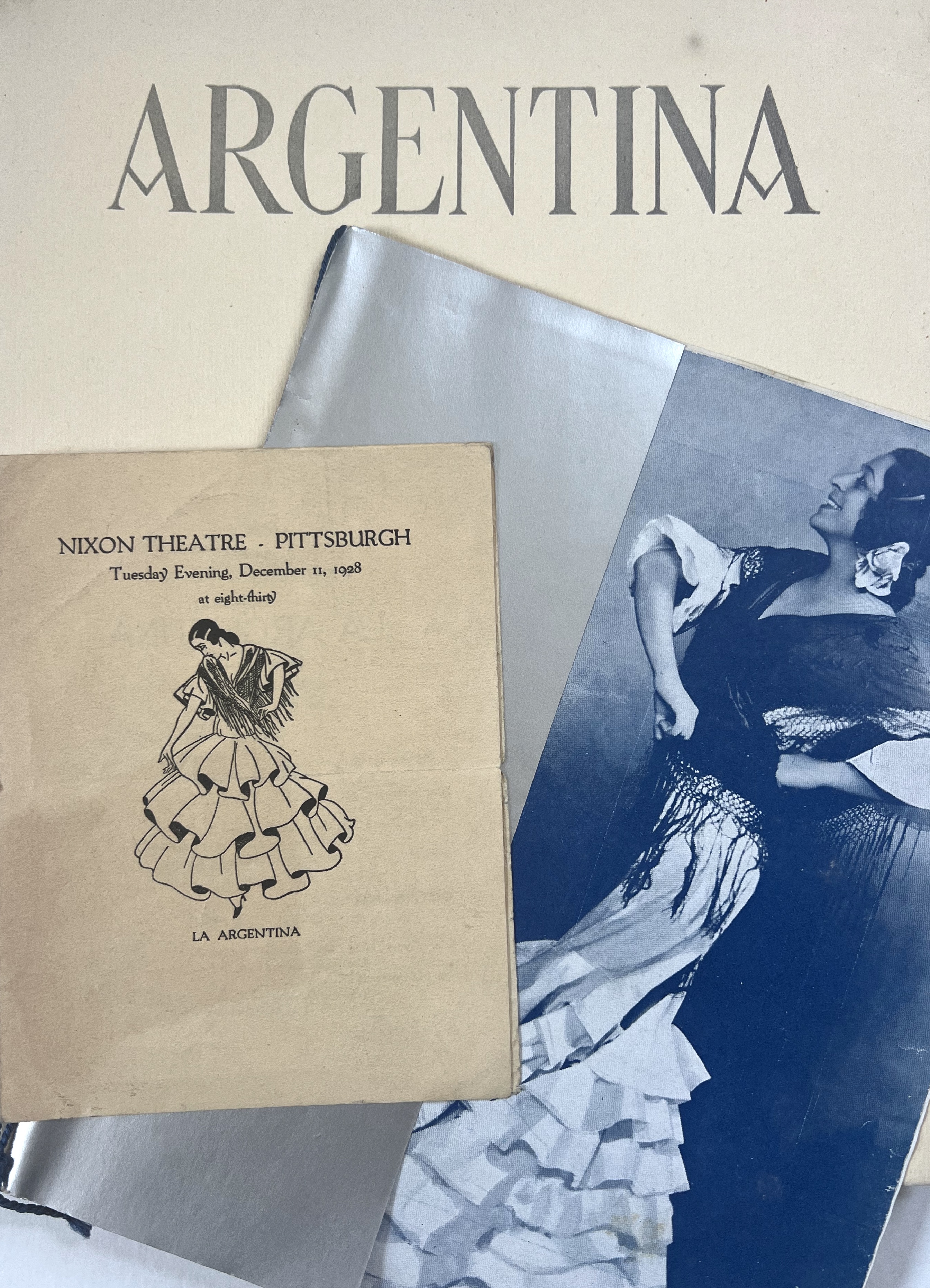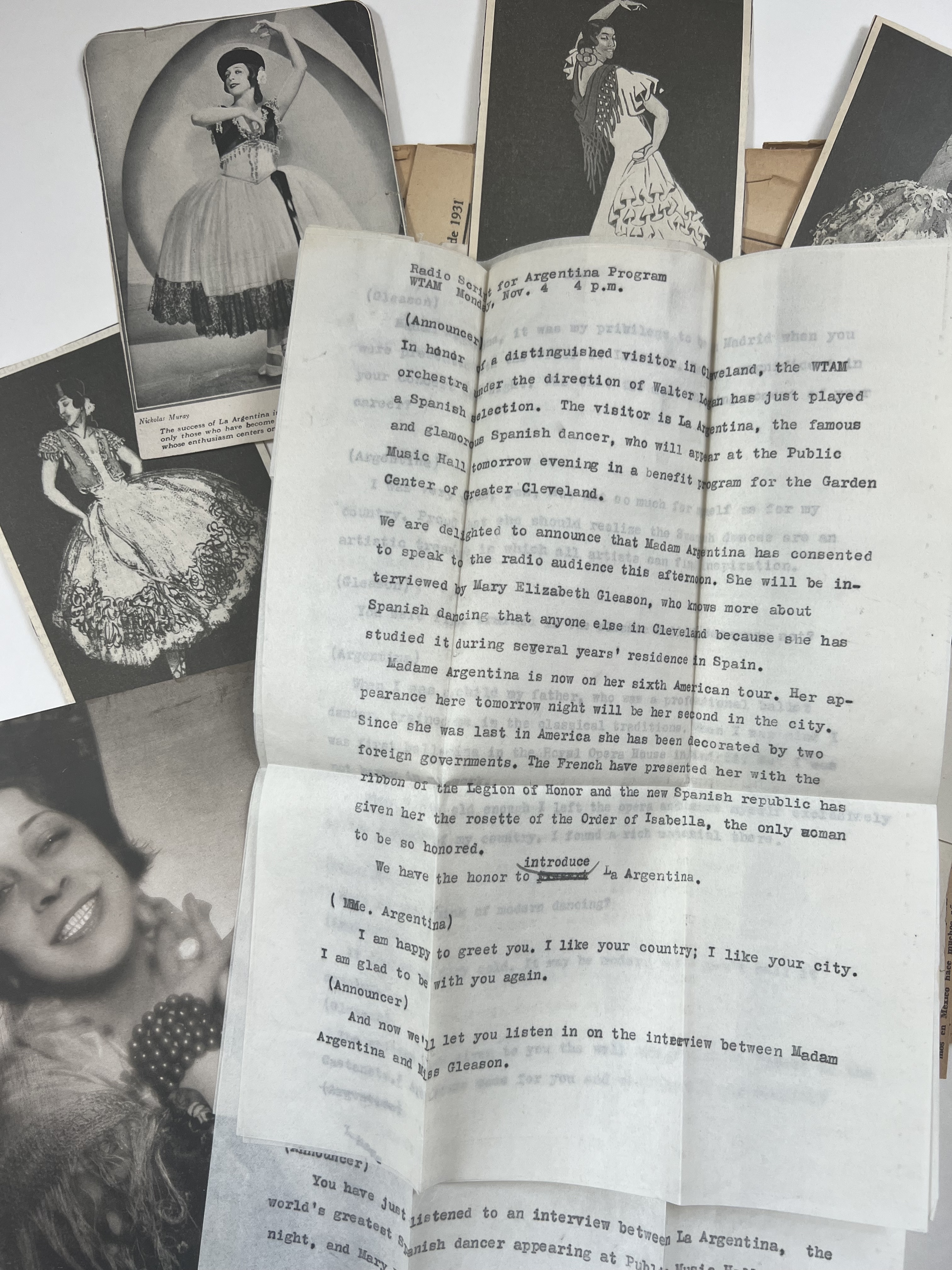GRAPH BOOKS: PRINTED MATTER FROM RADICAL ART AND SOCIAL MOVEMENTS.
FEMINIST HISTORIANS OF MATERIAL CULTURE.
La Argentina: A Collection of Photographs, Postcards, Programs, Reviews, and other Publications
ca. 1928-1933

(Dance) [Mercé, Antonia, “La Argentina”]; [Dora Kallmus, “Madame d’Ora”] and [Mary Elizabeth Gleason]. La Argentina: A Collection of Photographs, Postcards, Programs, Reviews, and other Publications, ca. 1928-1933.
An excellent group of primary source materials surveying the career of internationally renowned choreographer, dancer, and director, Antonia Mercé (1888-1936), known as La Argentina. Born in Buenos Aires, Mercé and her parents–both dancers–moved to Spain when she was a child; by the age of 11 she was a star ballerina at the Teatro Real de Madrid. She retired from ballet at 17 and began to study native Spanish folk dances. She has been described as an “assiduous ethnographer, combing Spain for rhythms, materials, and design concepts” and her interpretations of these dances, including bolero and flamenco, played an important role in the popularization and modernization of these forms. Living in Paris and with Sergei Diaghilev’s Ballets Russes as her model, she founded the company Les Ballets Espagnols, creating an avant-garde forum for Spanish dance and music. Her collaborative dance-theater productions “offered a modernist vision of a multinational Spain,” fusing classical Spanish ballet with Roma flamenco rhythms and legends.
In her friend Federico García Lorca’s words: “All the classical dances of this great artist are her unique signature, at the same time that they are the signature of her country, of my country.” Despite being awarded the French Légion d’honneur and dancing at the Roosevelt White House, her significant contributions to Spanish modern art and her position as the director of the largest ballet company in Paris (after Diaghilev’s death) were largely forgotten during the Franco dictatorship.
Most of the portraits in this collection were photographed by Dora Kallmus, a.k.a. Madame d’Ora, the Austrian-Jewish emigre whose Parisian studio was frequented by the Who’s Who of 1920s Parisian art and fashion: Coco Chanel, Colette, Pablo Picasso, and Josephine Baker, etc.
The clippings and programs were assembled by Mary Elizabeth Winbigler, née Gleason, an American dancer inspired by La Argentina who studied flamenco in Spain in the 1920s and performed in Madrid under the name “Marie Isabel” in 1931. When she returned to the US she organized a 50-member dance troupe who toured during the Depression, often performing as an opening act in movie theaters. The collection includes the typescript of a radio interview between Gleason and Argentina in 1935.
SOLD
Consisting of: Ten publicity postcards, all reproducing photographs of Argentina taken by d’Ora (five 10 x 14.5 cm, five 9 x 14.5 cm), one with holograph signature by Argentina, Madrid, 1931; three duplicates, two of the dupes with different programs advertised verso. Five programs: 1.) A Recital of Spanish Dances by La Argentina with Assistance of Carmencita Perez, Pianist, Pittsburgh: Nixon Theatre, December 11, 1928. Single sheet, folded 15 x 11.5 cm, with pictorial illus. on cover. 2.) Récital de Danse Espagnole donné par Mme Argentina avec le concours du pianiste Luis Galve, Paris, ca. 1933. 23.5 x 19.5 cm, [10] pp.; stapled pictorial wrapper with foiled rear wrap and decorative satin cord. 3.) Les Représentations de Madame Argentina avec sa troupe de Ballets Espagnols. Paris: Théâtre Marigny, July 1929. 27 x 22 cm, [34] pp.; profusely illus. incl. 4 b/w plates tipped in. Stapled color illustrated wrapper with decorative satin cord and original glassine overlay (now darkened). Gleason’s copy of this exceptional program exemplifies the height of Argentina’s success with her Ballets Espagnols. With a single sheet program tipped in for a Vincente Escuedro flamenco recital at Severance Hall, Cleveland, 1932. 4.) Two copies of Hommage a La Argentina par Nana de Herrera, Paris: Grande Salle Pleyel, 18 Juillet 1941. 25 x 21.5 cm, decorative satin cord binding, covers with full-page reproduction of d’Ora studio image of La Argentina. One copy lightly foxed in one corner, the other with a small closed tear at spine. Seven vintage publicity photos: gelatin silver prints, six approx. 16.5 x 22.5 cm, one 13 x 11.5 cm; five signed d’Ora in negative, two photographs by Madrid studio photographers, known to be used in advertisements ca. 1935. Folder of clippings: approx. 16 items from English and Spanish language sources, with articles about La Argentina and images, including reproductions of her costumes. Radio Script for WTAM, Cleveland: 4 pp. typescript of interview between Mary Elizabeth Gleason and La Argentina broadcast on Monday, November 4, 1935, discussing modern dance and La Argentina’s Order of Isabella award [the first woman to be so honored?] shortly before La Argentina’s untimely death. Together with Gleason’s copy of: Levinson, André, La Argentina: Essai sur la danse espagnole avec 32 reproductions en phototypie. Paris: Éditions des Chroniques du Jour, 1928. No. 259 from 365. French self-wrappers separating from text block, pages starting. With Mary Elizabeth Gleason’s bookplate.
See Ninotchka Devorah Bennahum, Antonia Merce, La Argentina: Flamenco and the Spanish Avant Garde, Wesleyan University Press, 2000.
